#grasshopper biology
Explore tagged Tumblr posts
Text
Taxonomy Tournament: Insects

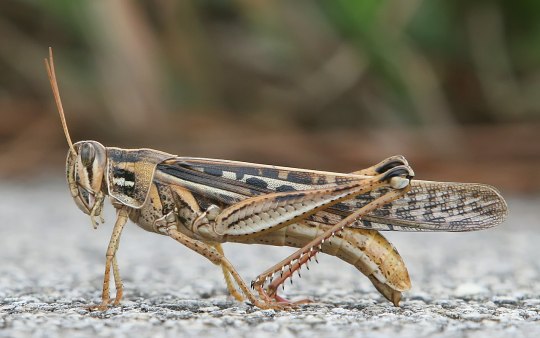
Phasmatodea. This order is made up of insects that mimic plants. Members include stick insects and leaf-bugs
Orthoptera. This order has elongated hindlegs adapted for jumping. Members include grasshoppers, crickets, and katydids.
#animals#biology#polls#poll tournament#zoology#stick insects#leaf bugs#arthropods#insects#ecdytes#grasshoppers#crickets#katydids#Phasmatodea#Orthoptera#0x42v0xbd#animal tournament#Animal Tournament Round 1
418 notes
·
View notes
Text


Today we have two creatures! Both most likely Common Green Grasshoppers. I was out on a walk with my dad, I think it was in late summer some time, and the grass was absolutely filled with crickets and grasshoppers. Every time I'd pause and just watch the grass I'd just see the everything moving, it was amazing. Even though it was still warm and mostly clear, it rained a little and my camera lens got steamed up, so some of my photos from that day have a greyish blurriness to them. Luckily these were unaffected and the grasshoppers are fully visible.
#bugs#animals#entomology#insect#bugblr#biology#insects#grasshopper#bug photography#insect photography#tw bugs#cw bugs
13 notes
·
View notes
Text
December 22nd, 2023


Clubhorned Grasshopper (Aeropedellus clavatus)
Distribution: Found throughout western North America, north to Alaska and south to Arizona, and as far west as Manitoba and the midwest.
Habitat: Two populations exist, one found in low-elevation prairies, fields and pastures, and another found mainly in mountain meadows and tundras up to an elevation of 4150 metres. They aren't found in elevations between low prairies and high meadows.
Diet: Mainly herbivorous; feeds mostly on grasses and sedges, but has also been found to eat fungi, pollen and bits of other arthropods.
Description: Predictably, club-horned grasshoppers are named so due to the presence of blunt "clubs" at the end of the males' antennae, which are not present on females and nymphs. These insects hatch much earlier than most, and also have a very quick nymphal development; this accelerated life cycle is common among insects living in boreal habitats. Because adult grasshoppers emerge fairly early, they benefit from a greater selection of green grasses and sedges than their competitors. There is a cost, though, as this also means that they're preyed on more often by common predators such as birds, rodents, spiders and other carnivorous insects.
Images by Robert Webster (male) and Larry de March (female).
35 notes
·
View notes
Text

Valley Grasshopper (Oedaleonotus enigma)
#inaturalist#naturalist#nature#ecology#zoology#biology#wildlife#insect#insects#bug#bugblr#entomology#bugs#insectblr#photography#nature photography#wildlife photography#hawks photos#animal photography#grasshopper#grasshoppers#bugposting
14 notes
·
View notes
Video
20240309_F0001: Look what I found, a grasshopper by Wei-Feng Xue Via Flickr: - From a trip to the Lake District over #10YearsAgo. Here I found a really nice looking grasshopper amongst the rocks.
2 notes
·
View notes
Text
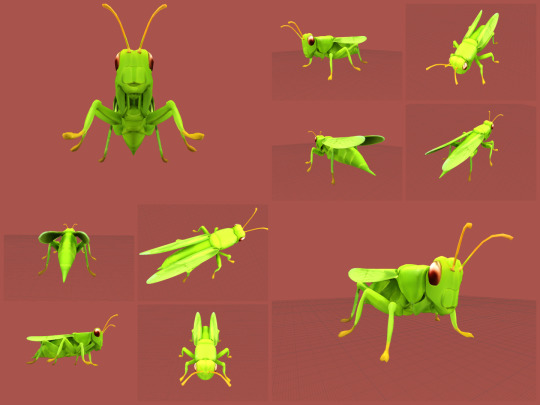
https://www.behance.net/gallery/214166691/Grasshopper-Green-Realistic-Lowpoly-3D-Model
#animal#animals#antenna#antennae#art#biology#bug#character#creature#digital#environment#fly#grasshopper#green#insect#legs#model#nature#pest#wildlife#wings
0 notes
Text
My advice to everyone who sees a fat ass stink beetle is pick it up. I picked up three over the course of a few hours on my trip and then held them between their abdomen and thorax and they all didn’t care that much. They also didn’t do their namesake. The first one just kind of stood there, the second one actually pushed itself out of my grasp, and the third one tried walking on the air away from me. I’d generally say that, the bigger the bug the lesser fucks it will give. Think robber fly or giant millipede. If I get stinked in the near future that’s on me also probably don’t listen to this advice I just don’t see fat ass beetles often.
#bugs#biology#rambles#I also picked up two big grasshoppers#and I briefly saw a kestrel and a red velvet wasp!#I swear bru I was meant to live in the grassy deserts with a statellite tower near and a snake in my arms#all little biobot’s dreams#bad post
0 notes
Text
I've been sorting through my old photos a bit and found a LOT of cool bugs I never got around to posting, so for a while my posts will be those. I may accidentally post one I've already done before, but hopefully they all be new and shiny.
First off, the oldest bug photo I have, this lovely grasshopper from 2013. It's been so long that I can't even slightly remember this, but it's one of my favourite photos.

The text on the photo really adds to it for me, it feels so nostalgic.
19 notes
·
View notes
Text
I need to make ocs
I love when arthropods have a pseudopupil. It's so whimsical and cute, and they come in so many varieties!!

little kitty cat eyes!!!
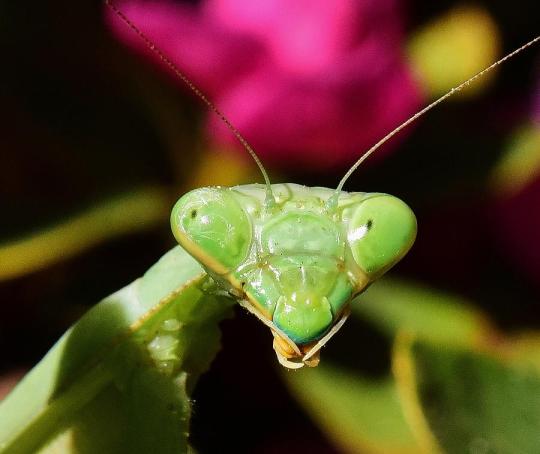
bombastic side eyes!!!!
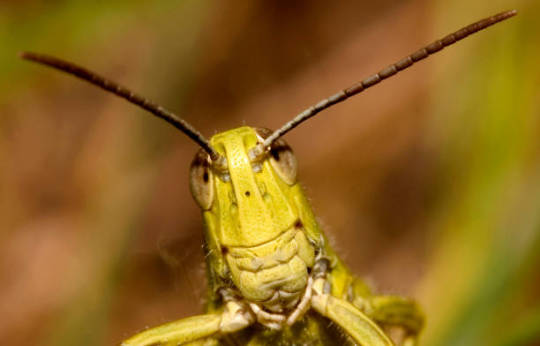
cartoon character eyes!!!!

bigass anime eyes!!!!!

BE NOT AFRAID eyes!!!!!
6K notes
·
View notes
Text
February 9th, 2024


Painted Grasshopper (Poekilocerus pictus)
Distribution: Found in India, Pakistan, Afghanistan, Nepal, Bangladesh, Sri Lanka, Bhutan and the Maldives.
Habitat: Show a preference for dry regions.
Diet: Adults and nymphs most often feed on milkweeds of the genus Calotropis, especially C. gigantea and C. procera. In absence of their preferred food sources, they will feed on a wide range of other plants, including agricultural crops such as wheat, papaya, citrus, castor, eggplant and mango. They will occasionally resort to cannibalism if they're starving.
Description: The painted grasshopper's most well-known trait is their toxicity, which stems from their diet of toxic milkweed sap, the toxins in which are classified as cardiac glycosides and have historically been used in the creation of poison arrows. Nymphs in particular also have the ability to spray noxious liquid when they're grabbed, to a distance of up to 30 centimetres; when any pressure is put on their head of abdomen, a jet of the viscous, milky liquid is aimed towards the sources of the pressure, with both an unpleasant smell and taste as well as a dose of cardiac glycosides. Adults can also discharge this liquid, though instead of emitting a jet, it comes out as a viscous foam leaking out of the sides of their bodies.
This species is often kept as a laboratory animal in India, as they serve as a great model for the observation of spermatogenesis through meiosis. Their cells also contain a chromosomal repair mechanism that counteracts the effects of mutagens during meiosis, prompting research on the enzymes and mechanisms involved in this process.
Images by Haneesh K.M. (adult) and Rohitansh Upadhyay (nymph).
19 notes
·
View notes
Text

bug
(Romalea microptera)
1 note
·
View note
Video
20240310_F0001: Grasshopper between rocks by Wei-Feng Xue Via Flickr: - From a trip to the Lake District over #10YearsAgo. This is a nice looking grasshopper climbing some rocky paths.
0 notes
Photo
i went on this and i got the grasshopper :D im scared of bugs but i like them a lot because they’re so pretty 🫶

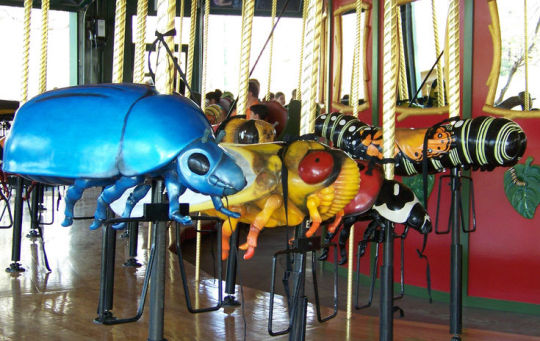
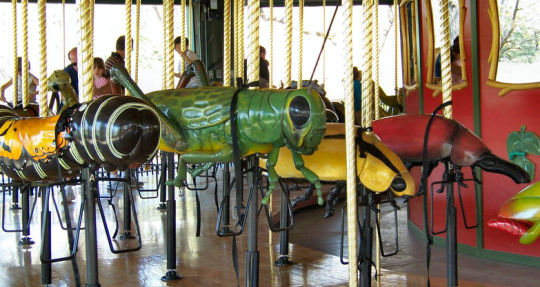
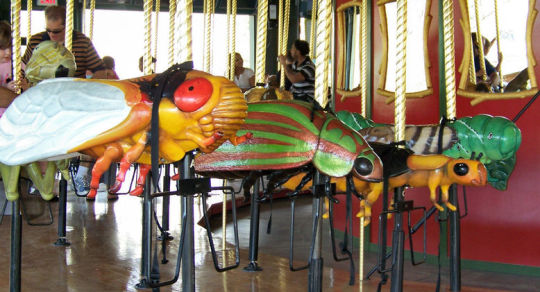
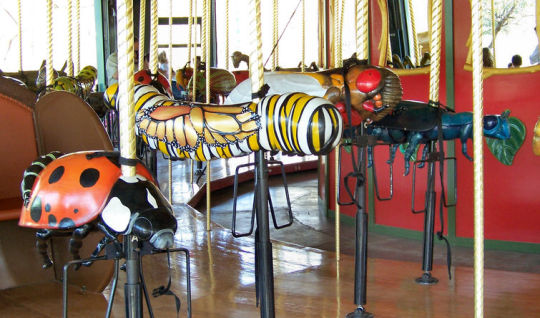
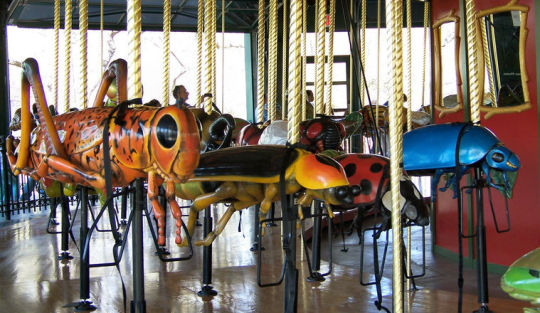
The Bug Carousel at the Bronx Zoo has all your favorite insects: a long-legged praying mantis, a bright green grasshopper, ladybugs, caterpillars, and even a dung beetle. (Photos by Jean Bennett)
#insects#animals#entomology#newyork#biology#science#sciart#marsh with mic#grasshopper#if i saw a live one i would scream but like they’re pretty#i would kill myself if i actually had to face one but in theory im so chill about them
26K notes
·
View notes
Text
"One of the least respected but most important ecosystems on Earth are seagrass meadows, and a pioneering robotic solution is helping marine scientists restore these underwater gardens.
The ReefGen Grasshopper can plant dozens of seagrass seeds per minute. Not only is this faster than a human diver, but much safer as well.
It works by injecting a tiny slurry of sediment wrapped around the seagrass seed into the seafloor. After covering a growing plot of four seeds, the robot ‘hops’ about 30 centimeters away and starts again.
Despite covering a minuscule portion of the seafloor, seagrass meadows are estimated to hold 35-times more carbon than terrestrial forests—amounting to around 18% of the total carbon stock of the world’s oceans.
ReefGen’s founder Tom Chi dreamed up the idea after watching the degradation of coral reefs on his home island in Hawaii. The first iteration of the robot set coral ‘plugs’ onto existing reefs to help regrow them, but the technology was prohibitively expensive for wide-scale use.
Now however, broader selections of off-the-shelf parts have driven down the costs of manufacturing and maintaining underwater robots, according to Chris Oakes, CEO of ReefGen.
“Manual planting works, but robots are really good when things are dull, dirty, dangerous, or distant—the four Ds,” Oakes told CNN, adding that at the moment, Grasshopper is piloted with a controller by a human on the surface.
“Right now, we’re focused on the planting, the biology, and the mechanical aspects, once we’re confident that that’s all designed the right way, we will overlay more semi-autonomous features like navigation, so you don’t actually have to pilot it,” he said.
ReefGen has been able to not only expand into restoration of seagrass meadows, but also see its robots used in oceans around the world. This July, Grasshopper planted 25,000 seeds in Wales. In October, ReefGen teamed up with the University of North Carolina (UNC) Institute of Marine Sciences to test various seed replanting methods out on the state’s declining seagrass meadows.
Oakes says that as cool and “flashy” as a robotic solution might seem, the most important factor in its success will be the long-term monitoring of the fields it’s replanting. Are they growing to maturity, are the seedlings dying off before then, will they live long enough to seed and germinate fields of their own, how do fields it plants compare to fields planted by hand??"
-via Good News Network, December 24, 2024
#marine biology#ecology#seagrass#seagrass meadows#ocean#hawaii#wales#north carolina#united states#uk#north america#europe#robots#environment#climate action#good news#hope
2K notes
·
View notes
Text
my bio professor, in a convoluted roundabout way, basically just said Brad Pitt looks like a grasshopper
1 note
·
View note
Text
Avian Expectations
A small essay about the difference between the pop culture Bird and being a bird.
Being a bird is probably one of the most romanced identity. Being a bird means nothing, behavior wise, scientifically. Yet, being a bird portrays something very specific into people's mind.
Being a bird is freedom. It's effortless flight, belonging to the realm of air and never wanting to touch ground again. Being a bird is adventure, migration. A good half of movies about birds are about overcoming the thrilling dangers of going over entire continents in one year, the reward of seeing an exotic haven far from the cold. Sometimes, being a bird is being a strange endearing critter, voice mimicry, stealing shiny things, cuddling up and preening one's flock. Other times, being a bird is a sharp beak and sharper claws and being the Predator from Above, undefeated in the heights.
I've seen a lot of people question birds with that idea of a bird in mind. And, clearly, it can be true. One bird I know is migratory to her very core, the pull of Africa leading her to travel, irresistible. Another deeply intertwined with the drop of gravity as it's ultimate strength, entire biology built to master it.
But I cannot relate to people who go into questioning bird from the perspective of the Pop Culture Bird Homonculus, of this chimera of all the Cool Bird Traits. It seems like a fictional character to me, without all the little details that make being a bird real. Perhaps it is because I break all of these core traits.
I do not fly well, I glide when I must, and more often I run. I much prefer the ground. I am not migratory, and one part of being a roadrunner to me is Territory, and Surviving winter. I've never had the luxury of fleeing the cold, as much as i dislike it. I do not mimic all that much, I am solitary, I hunt by running along the grass. Barely bird, in the eye of the Being a Bird rules.
Rules say, then, i should not relate to being a bird. perhaps being a roadrunner for me would be akin to coyotes. Perhaps it would be akin to cats. But no, i do in fact relate to birds.
As it turns out, there is still a strong difference, for me, between the Being A Bird non-birds imagine and the actual one. I don't fly, i glide, i struggle to get to heights. A heavy sea eagle responded, saying how they felt flight as tool, from perch to perch, to scan for prey, too costly to waste in play.
I say that i hunt on foot, that i do not relate to the dive of the kestrel or the flight of the swift. A burrowing owl answer; saying they too prefer hunting grasshoppers from their height, sometimes perching but often just lurking around the grass.
I say i am alone, i do not have a flock, and a heron responds, why should you ? You are fine on your own.
I have met flightless cormorants, I have met penguins. On the contrary, I have met falcons, I have met corvids. The shapes of birdhood shift and change, but in the end, I tend to find someone for each things, be it bird like or not. Bird is a wide ground. Bird is a simplification, so that others can understand a flawed but easy view.
I am not A Bird, by pop culture definition. Yet i am very much a bird who relates to beings extremely far from me, behaviorally. honestly there's a point of no explanation. I share phantom feathers with them and beaks, but i couldn't be further from a hummingbird. It's a strange conundrum. So close yet so far, every species that talks about it. always slivers of Me-Truth, always things i just gloss over. a bird is not an animal, its a concept. i wish people would take that in account more before diving in it.
207 notes
·
View notes
